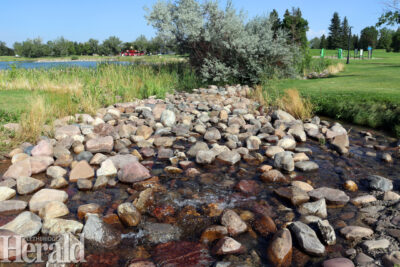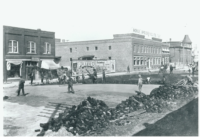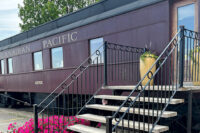Irrigation district has to consider wide range of needs
By Al Beeber - Lethbridge Herald on August 20, 2024.
 Herald photo by Al Beeber
Irrigation water flows over rocks and into Nicholas Sheran Lake on Monday afternoon. Water that fills Nicholas Sheran, along with some other city lakes, comes from the Lethbridge Northern Irrigation District.
Herald photo by Al Beeber
Irrigation water flows over rocks and into Nicholas Sheran Lake on Monday afternoon. Water that fills Nicholas Sheran, along with some other city lakes, comes from the Lethbridge Northern Irrigation District.LETHBRIDGE HERALDabeeber@lethbridgeherald.com
Timely rains and a cool spring enabled the Lethbridge Northern Irrigation District to increase water allocation to members this year but dam levels are still being monitored to ensure that organization does its part for water conservation in the area.
The LNID was one of many organizations who had tents set up at Farming Smarter on Saturday for Open Farm Days.
About 20 farms and even a micro-brewery participated locally in the 12th annual province-wide initiative aimed at giving urban dwellers a look at agriculture and gain some knowledge about the industry and the people involved in it.
Over the decades, the irrigation industry has through technology reduced evaporation of precious water and increased the amount of acres that can be given water.
PVC pipelines have replaced leaky canals and low-pressure pivots and drop tubes are putting bigger drops of water right where the moisture is needed.
Some areas previously lost half their water in seepage and now that is being saved.
Peter Bos, a board member of LNID, said irrigators are diverting less water and serving more acres.
“We’re putting the water on way more efficiently.”
Bos said the spring rain was “absolutely amazing.”
He said the LNID would have liked to see more rain this summer but overall “it’s amazing. Who would have ever thought we’d have that rain we received in May? It was excellent.”
Reservoir water levels enabled LNID to increase their initial allocation from eight to 11 inches which Bos says is still tight for some crops but overall it’s good.
LNID is a large district that extends from west of Fort Macleod north to Barons and east to Turin, covering a total of about 200,000 acres. Water that fills Nicholas Sheran, Sunridge and Riverstone lakes comes from LNID as does the water used on the Paradise Canyon golf course, says Bos.
Chris Gallagher, general manager of LNID who was also at the Farming Smarter event on the Jail Road just east of the city limits, said irrigation has come a long way over the years.
“Just the number of acres we’ve been able to serve with the same amount of water or actually even less water because of on-farm irrigation efficiencies that the farmers choose to use for equipment for applying water to the field as well as covering a lot of open canals to pipeline” is the reason for the efficiencies, said Gallagher, adding more acres are being irrigated with less water.
Climate change is a significant consideration for irrigators, he said, noting that water is being saved faster than acres are being added for irrigation.
“That difference is a nice buffer for us to adjust as a contingency for climate change. Farmers are risk takers but they’re also good managers.
LNID has an expansion plebiscite passed from about a decade ago which is set up so parcels of expansion acres are available for the board to approve in any given year based on a five-year rolling return.
“Basically we have to prove that we’ve saved the water before we let the irrigation acres go,” said Gallagher.
“We always save the water first.”
He said 2024 has been a challenging year with water allocation starting at eight inches, matching what other districts did as part of the water sharing Memorandum of Understanding.
The Oldman dam reached 96.2 per cent, Keho dam was at 98 per cent and the LNID board said that farmers were going to see agro-economic impacts so it wanted to increase allocation “which was still a conservative number and make sure that our farmers aren’t suffering for no good reason,” said Gallagher.
A cool spring, good snowmelt and soaking rains allowed farmers to start the first month of the season with very little irrigation, said Gallagher.
“The water they saved early in the spring is now being used to make sure that their crops are able to finish. Right now, it’s very very high water use,” he said, adding that water demand is much higher than normal right now.
But because of spring savings “we’re still going to be OK and the crops are looking really good. We’ve got some happy farmers” and some are asking for more water because they’re reaching allocation limits on certain fields.
“We are going to be taking a close look at that,” said Gallagher, adding the LNID needs to consider how much water is needed to conclude the irrigation season this year successfully while being responsible for saving enough for next year.
The LNID has different climatic regions that vary in the amount of rainfall they get and different types of soils ranging from heavier clays to light sand.
“With the lighter, sandier soils there’s less water holding capacity so you have to water irrigate more,” Gallagher said.
“We have to think across the board on how do we manage it so that we’re taking care of those who have high water use needs as well as being responsible for those who are able to save and conserve.”
30-29





“Climate change is a significant consideration for irrigators, he said, noting that water is being saved faster than acres are being added for irrigation.”
Er … so the half dozen planned reservoirs and $200 million gift from Alberta taxpayers to expand irrigation by 200,000 acres is ‘saving’ water. Water ‘saved’ is water left in the rivers.
If climate change were being considered, we wouldn’t be overallocating non-existent water at huge public expence to grow potato chips and fries.